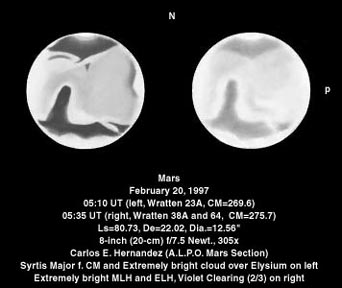

The red light (Wratten 23A) drawing of Mars on the left was made on February 20, 1997 (Ls=80.73, De=22.02) at 05:10 UT (CM=269.6) by Carlos E. Hernandez (A.L.P.O. Mars Coordinator) using an 8-inch (20-cm) f/7.5 Newtonian reflector at 305x. The North Polar Cap (NPC) appears small and brilliant (10/10) with an irregular (southern) edge as well as a remnant (Cecropia) visible p. the CM. A dark to dusky (3-4/10) northern maria collar is visible to the south of the NPC consisting of Lemuria, Panchaia, Uchronia, Utopia, and Cecropia. Casius is visible on the CM as a dark (3/10), curvilinear (towards the west, or f.) albedo feature with a dusky (4/10) Nodus Alcyonius, partially obscured by a bright to very bright (7.5/10) veil over the Aetheria-Neith Regio-Umbra-Dioscuria region, visible Sp. it. Protonilus is visible as a dusky (4/10), curvilinear albedo feature over Dioscuria towards the f., or morning, limb. The Hyblaeus Extension appears dusky (4/10) f. a very bright to extremely bright (8-9/10) Elysium visible on the terminator. An extremely bright (9/10) evening limb haze (ELH) is visible as well. Syrtis Major is prominent (3/10) f. the CM whereas its p., or eastern, border appears brighter (5-6/10) as if obscured by a veil. An extremely bright (9/10) cloud is noted over Libya which apparently connects to a very bright (8/10) border surrounding Syrtis Major. The f. end of Mare Cimmerium (3/10) is visible on the Sp. limb along with a "finger-like" Tritonis Sinus (3/10). A bright to very bright (7-8/10) Hesperia appears to separate Mare Cimmerium from a dark (3/10) Mare Tyrrhenum. Iapygia Viridis appears dark (3/10) along with Mare Serpentis and the p. end of Sinus Sabaeus. The southern limb appears extremely bright (9/10), especially p. the CM, covered by a southern limb haze (SLH). Hellas appears bright to very bright (7-8/10)
The blue (Wratten 38A) and blue-green (Wratten 64) drawing on the right made at 05:35 UT (CM=275.7) on the same date and using the same instrument depicts an extremely bright (9/10) MLH, ELH, and SLH. An extremely bright to brilliant (9-10/10) orographic cloud was visible over Elysium on the terminator. The North Polar Cap (NPC) appeared brilliant (10/10). A prominent (2/3) violet (blue) clearing was noted; a violet (blue) clearing refers to a poorly understood phenomena whereas dark albedo features (normally prominent while using red (W23A or 25) or orange (21) filters) are readily observed while using a dark blue (W38A) to violet (W47) filter. It is graded on a 0 to 3 scale (0=surface features distinguished with certainty, 1=weak surface features distinguished, 2=surface features moderately prominent, and 3=surface features seen as well as in white light). The violet (blue) clearing is thought to be due to a settling out of a layer of fine dust normally suspended in the martian atmosphere. Changing angles of viewing and solar illumination may also play a role in this phenomena.
(Legend: N.=north, S.=south, p.=preceding, f.=following, Np.=north-preceding, Nf.=north-following, Sp.=south-preceding, Sf.=south-following)